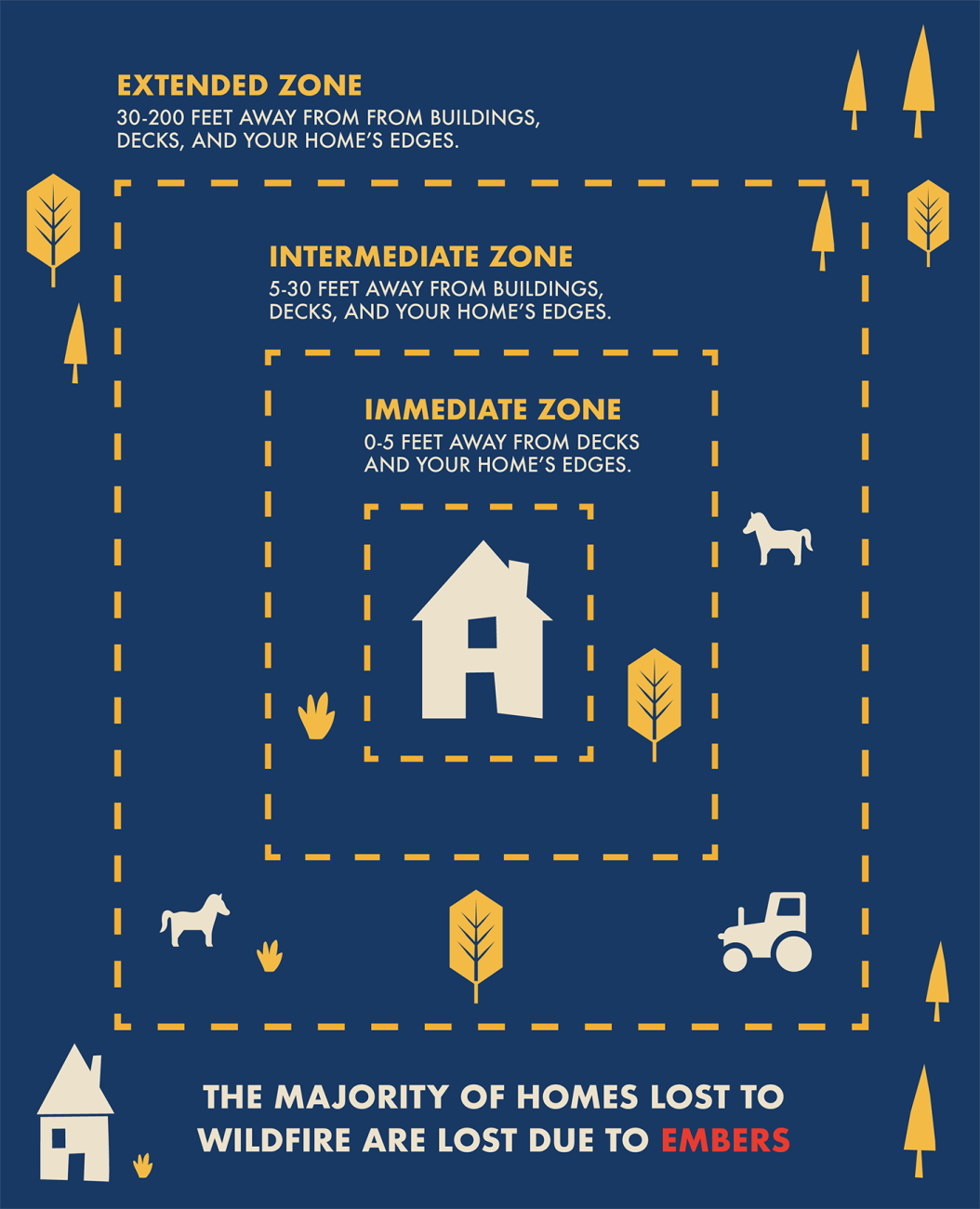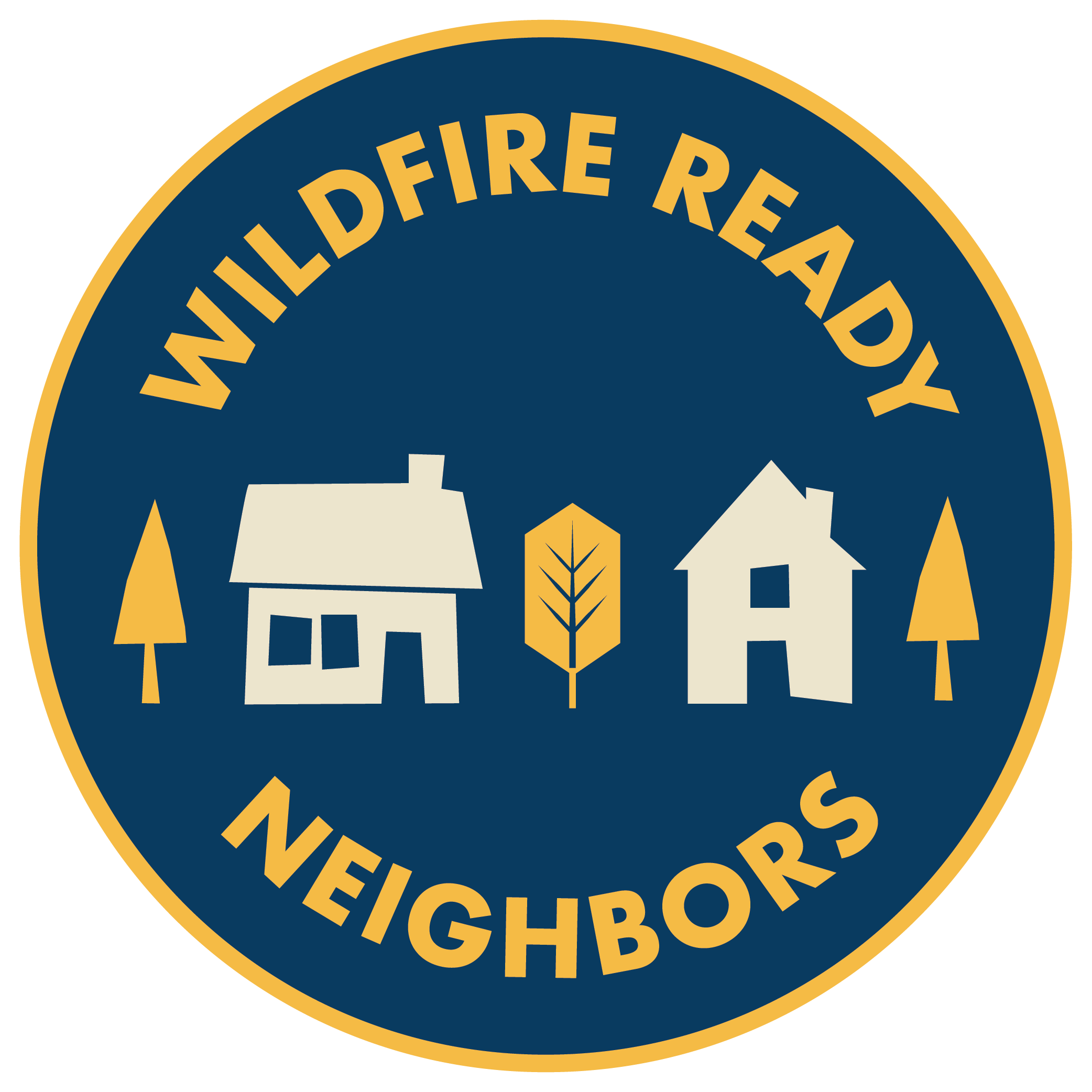WILDFIRE READY TODAY: Whether you rent, own a vacation home, own a forested property, or just live in a home with a backyard, we offer clear steps to help you prepare for wildfires. It all starts with your community. Step one is to engage with your neighbors and develop a plan, because one of our best defenses against wildfire is collaboration.
WILDFIRE READY TOMORROW: The steps you take today are a great beginning, but it’s important we look at wildfire resilience over the long term. Because when we get there, the payoff is huge: A wildfire-ready home and a community of neighbors who are all working together to keep it that way.
We know that reducing wildfire risk is hard work. That’s why your local wildfire experts have created a plan for you that’s realistic, doable and makes sense for your property. Use this Wildfire Ready Plan to find your starting point and map out a plan for long-term wildfire preparedness every month, every season, and every year.
YOUR ACTIONS HELP KEEP ALL OF US SAFER
No form data found.
- CREATE A DEFENSIBLE SPACE
-

Key: Top Priority - Free - Lower Cost
- ENGAGE WITH YOUR NEIGHBORS
-
Schedule time to talk with your local wildfire experts
- Request a free Wildfire Ready Home Visit to determine how you should prepare your home and its immediate surroundings. During the visit, you’ll receive tailored recommendations that will help increase your home’s chance of surviving a wildfire. If you selected this commitment, someone from Wildfire Ready Neighbors will contact you to schedule your assessment.
- If your property is forested, request a free Forest Health Consultation to assess your forest’s health and identify potential problems and solutions with a local forester. During the visit, a local forester will help you determine the management practices that best match your goals and are optimal for your forest’s health. If you selected this commitment, someone from Wildfire Ready Neighbors will contact you to schedule your assessment.
- If you already signed up for a home visit or consultation on our website, hang tight! Someone will be in contact with you for scheduling.
Support your local fire district
- Install reflective address signs with 4-inch lettering on your home, and where your driveway meets the main road to help first responders save lives during wildfire incidents and medical emergencies.
- Volunteer! Local fire districts are always looking for new volunteers who want to serve the community and can dedicate their time. Not sure which fire district you’re in? Contact your county’s emergency management department.
Stay connected to your neighbors and lend a helping hand
- Stay connected to your neighbors by creating a shared list of everyone’s contact information. Once connected, stay engaged by talking to each other about the best way to prepare your home and properties for wildfire.
- Work with your Homeowners Association or form a neighborhood committee to create a joint action plan. You can even request a neighborhood wildfire risk assessment.
- Join the Firewise USA® recognition program to help your neighborhood collaborate to reduce fire risk. More info at firewise.org.
- Team up with others in your neighborhood to lend a helping hand to those who aren’t able to prepare for wildfires on their own.
Are you a renter?
- If you’re a renter, talk to your landlord about Wildfire Ready Neighbors and the actions in this plan. By doing so, you’re helping to educate them on how to prepare your building and/or property in reducing wildfire risk. Take note that this may include steps unique to your building, like tending to flammable landscaping and common areas such as courtyards and pools.
- ANNUAL ACTIONS
-
Remove all flammable items within 5 feet of your home’s edges
- Create a non–flammable perimeter by removing all flammable items within the Immediate Zone, such as debris, dead vegetation, pine needles, wood scraps and other ignitable materials such as newspapers, boxes, or firewood. This includes removing anything flammable underneath decks or porches.
- Remove flammable mulches and plants containing resins, oils, and waxes, such as arborvitae and juniper plants. Use crushed stone or gravel instead of organic materials like cedar mulch or bark. Plants within 5 feet of your home should be limited to low–growing, fire–resistant native plants and ground covers. Choose fire–resistant plants from this list found here: bit.ly/WAPlantGuide.
Protect your home against embers
- To reduce ember entry, use metal panels or a 1/8–inch metal mesh to screen or box–in the area below your deck. If exterior vents are not already ember–resistant, 1/8–inch metal mesh screening should also be applied.
- The roof is the most vulnerable part of your home. If you have an untreated wood roof, it is considered an extreme danger and should be replaced with Class A fire–rated materials listed here: bit.ly/2xEy9Av. Even if your roof is fire–resistant, regularly inspect it for loose or missing shingles and replace as needed.
- Clear pine needles and leaves from your gutters and roof on a schedule that makes sense for your property — most likely on a seasonal basis.
Maintain landscaping year-round
- A healthy plant is much more fire–resistant than a stressed one. Regular watering, pruning, and cleanup increases plant health, making them more resistant to wildfire.
- Spring and summer are high–growth times for grasses. Keep grass mowed to a height of 3 inches or less. Tall grasses spread fire rapidly, but when kept short can act as a fuel break to slow down or stop fire spread.
- Watering plants during summer helps keep them green and less flammable. Using drip irrigation and watering early morning or early evening is a water conservation–friendly way to keep things green in the summer.
- A stretch of no rain, followed by windy weather in the winter time before plants have begun to “green up” can also create conditions for rapid fire spread. Wintertime wildfires are not uncommon. Remove dry brush or dead vegetation from around immediate perimeter of the house.
Manage flammable invasive plants like Scotch broom and Himalayan blackberry on your property
- Flammable invasive plants not only spread fire more rapidly, but also outcompete native plants that are less flammable and provide important benefits for native birds and wildlife. To determine the best options for your property, visit the WA State Noxious Weed Control Board: nwcb.wa.gov.
- In general, removing the plant and its roots and seedlings helps prevent smaller infestations from spreading. For ongoing maintenance, seed or plant native species. Grazing by goats, sheep, cattle and horses can also be effective for managing growth.
- SEASONAL ACTIONS
-
Remove flammables in the Intermediate Zone
- Maintain healthy flowers, plants, and grasses within 30 feet of your home. Replace flammable plants with native, fire–resistant plants. Choose fire–resistant plants from this list found here: bit.ly/WAPlantGuide.
- Move firewood to a location more than 30 feet away from your home.
- Remove debris from roof and gutters.
- If you have a large propane tank in this zone, remove debris and any live plants, including overhanging tree branches, from underneath and within 3–5 feet around the tank.
Prepare for smoky skies
- Establish air filtration to remove fine particles from smoky air that can result in negative health effects. Learn how to DIY a box fan filter using a furnace filter and bungee cord here: bit.ly/DIYBoxFilter.
- Set AC units to re–circulate to keep smoke out of your home.
When it’s smoky
- Stay inside and stay hydrated.
- Mask up outdoors and limit your outdoor activity. N95 masks are recommended to protect against wildfire smoke.
Protect against fireworks
- Before celebrations, clear debris out of gutters as fireworks can land in the debris and start fires.
- Remove dry brush from around your home and outbuildings.
- Hose down bark or mulch with water the day of celebrations and keep a sprinkler running in the yard throughout the day and during fireworks.
Prune trees and manage vegetation in the Intermediate Zone
- Trim branches that overhang your home, porch and deck, and prune tree branches up to 12 feet from the ground (depending on the tree’s height). For shorter trees, do not trim higher than 1/3 of the overall tree height. In some cases, this may require help from a certified arborist. Plants containing resins, oils, and waxes, such as arborvitae and juniper trees, should be removed to reduce risk. Choose fire–resistant and drought tolerant plants from this list found here: bit.ly/WAPlantGuide.
- Sign up for a free Forest Health Consultation with a local forester to learn more about specific spacing, management, and landscape recommendations for your property. If you didn’t express interest for this service when you signed up for Wildfire Ready Neighbors, you can still request your consultation at wildfireready.dnr.wa.gov/visit.
Make an evacuation plan and practice it with your household
- Create an evacuation plan for you and your family that includes designated emergency meeting locations, escape routes, plans for pets and large animals, and other key items listed at redcross.org/wildfire.
- Visit nfpa.org/disaster for a list of items to include in your Emergency Supply Kit, such as a regularly updated list of emergency contact phone numbers. And, in case you can’t get home due to the nature of the emergency, be sure to keep an extra supply kit in your car.
- Sign up to receive notifications and public emergency alerts from your county’s emergency management department: mil.wa.gov/alerts.
SAVE YOUR WILDFIRE READY PLAN


